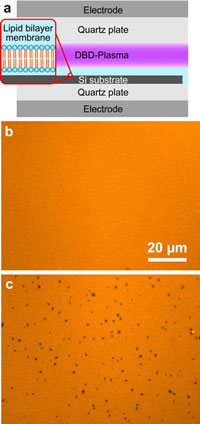| Sep 18, 2014 | |
Biomedical applications of plasma technology |
|
| (Nanowerk News) Atmospheric plasma is widely used for medical and biological applications including sterilization, selective killing of tumor cells, gene transfection, and healing wounds. | |
 (a) Schematic of the DBD-plasma irradiation of an artificial lipid bilayer membrane. (b, c) Fluorescence images of the lipid bilayer membrane (b) before and (c) after the plasma irradiation. Acidic and radical species generated by plasma first access a plasma membrane, the outermost layer of a cell. However, it is unclear how these plasma-induced species affect and/or permeate plasma membranes. Here, Ryugo Tero, Yoshiyuki Suda and colleagues at Toyohashi University of Technology report the effects of atmospheric plasma irradiation on an artificial plasma membrane system ("Plasma irradiation of artificial cell membrane system at solid–liquid interface"). A phopholipid bilayer membrane was prepared on a silicon wafer in an aqueous solution, and the atmospheric plasma was irradiated with a home-build dielectric barrier discharge (DBD) instrument. Observation with a fluorescence microscope and an atomic force microscope revealed that pores on the order of 10 nm to 1 µm in size were formed in the lipid bilayer membrane after the plasma irradiation. Capturing these micropores in a fluid lipid membrane is a significant advantage of the artificial lipid membrane system, and quantitative analysis of the pores was achieved. The results indicate that the micropores act as paths for the non-selective leakage or transportation of solutes into and out of cells during the plasma-induced phenomenon such as sterilization and gene transfection. The artificial plasma membrane system is valuable for studying the fundamental effects of plasma on biomolecules for establishing medical and biological applications of plasmas. |
| Source: Toyohashi University of Technology |
